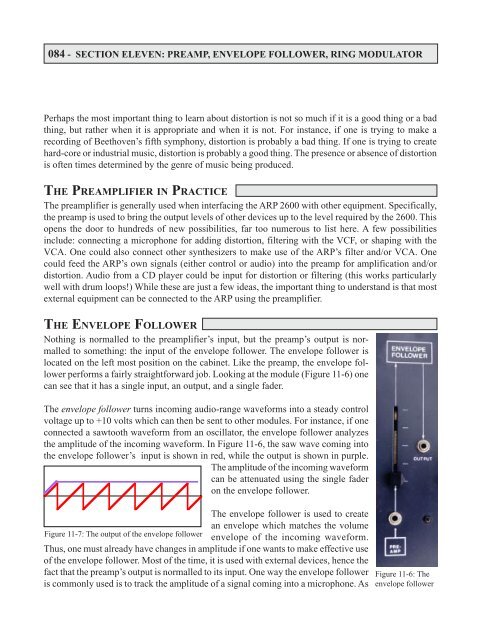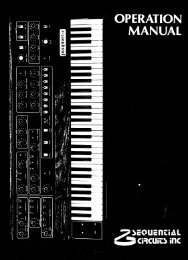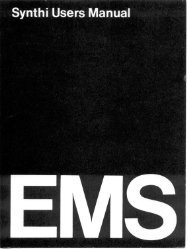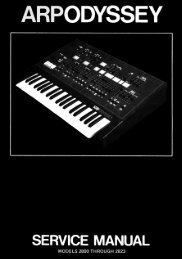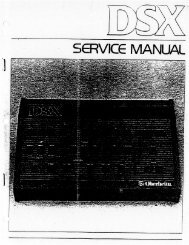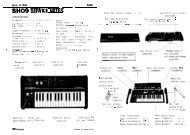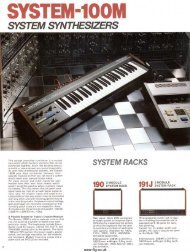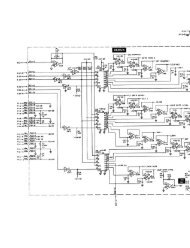ARP2600 - Fundamentals of Music Technology - Cyborgstudio.com
ARP2600 - Fundamentals of Music Technology - Cyborgstudio.com
ARP2600 - Fundamentals of Music Technology - Cyborgstudio.com
Create successful ePaper yourself
Turn your PDF publications into a flip-book with our unique Google optimized e-Paper software.
084 - SECTION ELEVEN: PREAMP, ENVELOPE FOLLOWER, RING MODULATORPerhaps the most important thing to learn about distortion is not so much if it is a good thing or a badthing, but rather when it is appropriate and when it is not. For instance, if one is trying to make arecording <strong>of</strong> Beethoven’s fifth symphony, distortion is probably a bad thing. If one is trying to createhard-core or industrial music, distortion is probably a good thing. The presence or absence <strong>of</strong> distortionis <strong>of</strong>ten times determined by the genre <strong>of</strong> music being produced.THE PREAMPLIFIER IN PRACTICEThe preamplifier is generally used when interfacing the ARP 2600 with other equipment. Specifically,the preamp is used to bring the output levels <strong>of</strong> other devices up to the level required by the 2600. Thisopens the door to hundreds <strong>of</strong> new possibilities, far too numerous to list here. A few possibilitiesinclude: connecting a microphone for adding distortion, filtering with the VCF, or shaping with theVCA. One could also connect other synthesizers to make use <strong>of</strong> the ARP’s filter and/or VCA. Onecould feed the ARP’s own signals (either control or audio) into the preamp for amplification and/ordistortion. Audio from a CD player could be input for distortion or filtering (this works particularlywell with drum loops!) While these are just a few ideas, the important thing to understand is that mostexternal equipment can be connected to the ARP using the preamplifier.THE ENVELOPE FOLLOWERNothing is normalled to the preamplifier’s input, but the preamp’s output is normalledto something: the input <strong>of</strong> the envelope follower. The envelope follower islocated on the left most position on the cabinet. Like the preamp, the envelope followerperforms a fairly straightforward job. Looking at the module (Figure 11-6) onecan see that it has a single input, an output, and a single fader.The envelope follower turns in<strong>com</strong>ing audio-range waveforms into a steady controlvoltage up to +10 volts which can then be sent to other modules. For instance, if oneconnected a sawtooth waveform from an oscillator, the envelope follower analyzesthe amplitude <strong>of</strong> the in<strong>com</strong>ing waveform. In Figure 11-6, the saw wave <strong>com</strong>ing intothe envelope follower’s input is shown in red, while the output is shown in purple.The amplitude <strong>of</strong> the in<strong>com</strong>ing waveformcan be attenuated using the single faderon the envelope follower.The envelope follower is used to createan envelope which matches the volumeFigure 11-7: The output <strong>of</strong> the envelope follower envelope <strong>of</strong> the in<strong>com</strong>ing waveform.Thus, one must already have changes in amplitude if one wants to make effective use<strong>of</strong> the envelope follower. Most <strong>of</strong> the time, it is used with external devices, hence thefact that the preamp’s output is normalled to its input. One way the envelope followeris <strong>com</strong>monly used is to track the amplitude <strong>of</strong> a signal <strong>com</strong>ing into a microphone. AsFigure 11-6: Theenvelope follower


